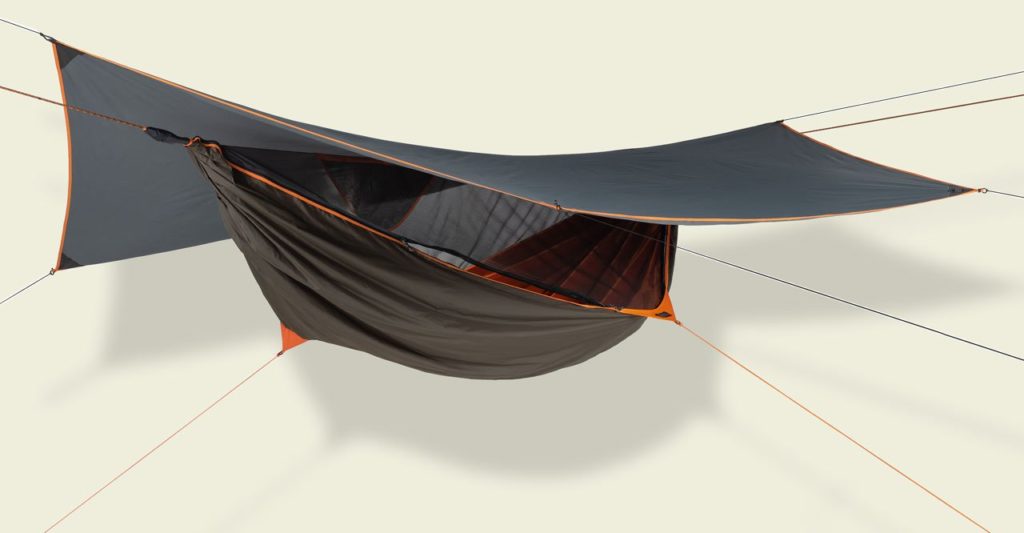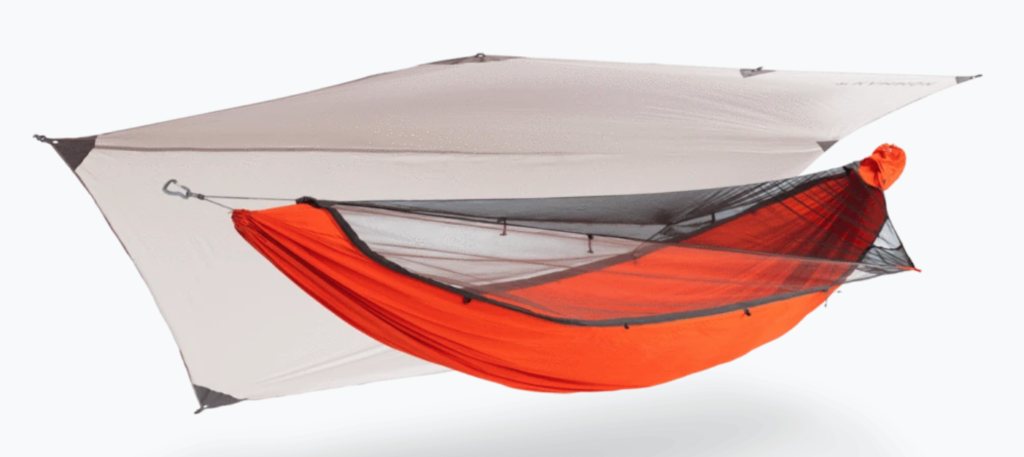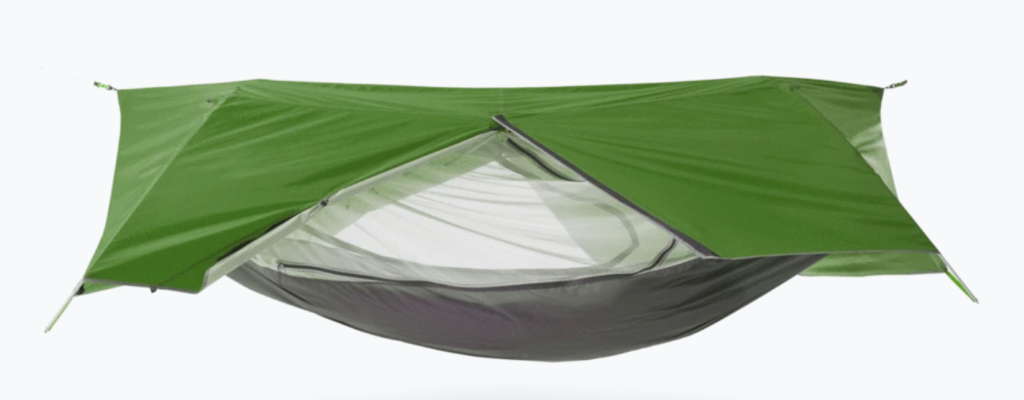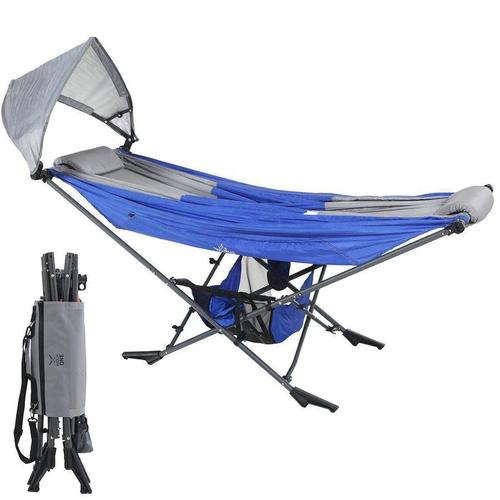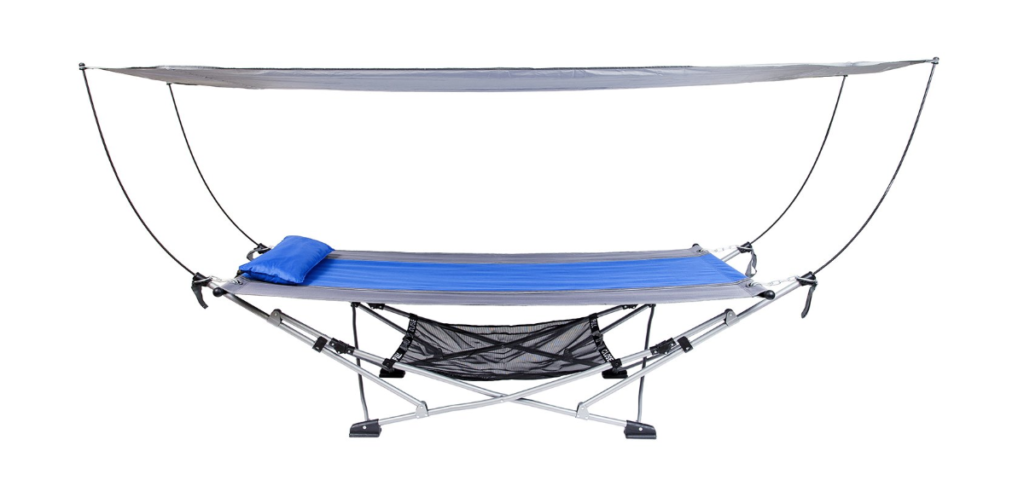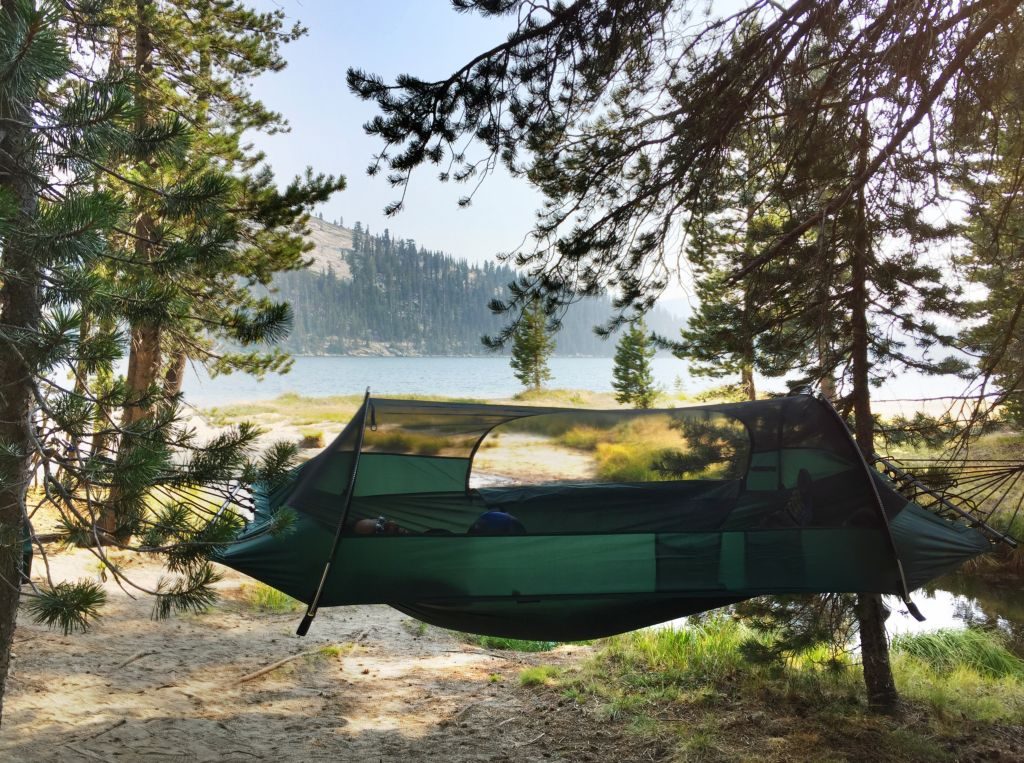
So you’re ready to ditch the tent and spend the night being serenaded by the sweet sway of a hammock? Good for you.
A good camping hammock will make all the difference as you embark on sleeping suspended in air.
There are definitely pros to hammock camping vs. tent camping, but there are also some things to consider before leaving the tent at home.
What are the benefits of hammock camping?
- Gear weight and size. If you’re car camping, it might not matter how much stuff you bring and how much it weighs. Though I have had to scale back on gear because the car was small or we had more people to accommodate. But the weight and size issue is more for backpackers who are counting every ounce and limited on how much they carry. Hammocks are much lighter and pack down smaller than tents.
- No sleeping pad required. For the most part, as long as the weather’s nice, you don’t need a sleeping pad. If it’s cold, there are sleeping pads made specifically for hammocks, or you can invest in a hammock underquilt.
- Comfort factor. Hammocks are incredibly comfortable, much more so than sleeping on the hard ground. Some camping hammocks are designed to be more taut/flat, so even a stomach sleeper can participate. That said, if it’s your first time trying hammock camping, we suggest having some kind of backup as insurance. Test out sleeping in a hammock during some afternoon naps to know your body likes it. Or, be extra cautious and bring a tent just in case if it’s an overnight trip. If you’re going backpacking with an ultralight hammock for the first time, try it out at home first.
- Time saver. Setting up and taking down a hammock can be done in the fraction of a tent.
- Breathability. It’s much cooler sleeping in a hammock in the summer than it is being stuck inside a tent.
- Versatility and accessibility. Unlike tent camping, hammock camping can be done in any terrain—hillside, over wet land, in a forest, wherever. That said, you do need trees…
- Multi-use. Hammocks also double as camp chairs and are a great place to relax and unwind. You’ll probably end up wanting to spend a significant amount of time in a hammock while you’re camping, and there’s nothing wrong with that!
- Money. Hammocks generally cost less than tents. Of course there are cheap tents and there are expensive hammocks, but overall, you can get a hammock to sleep in (and straps) for much less than a tent. And like we said, no sleeping pad to worry about. Just make sure you have straps and any other necessary accessories (see below), as that may affect the overall price.
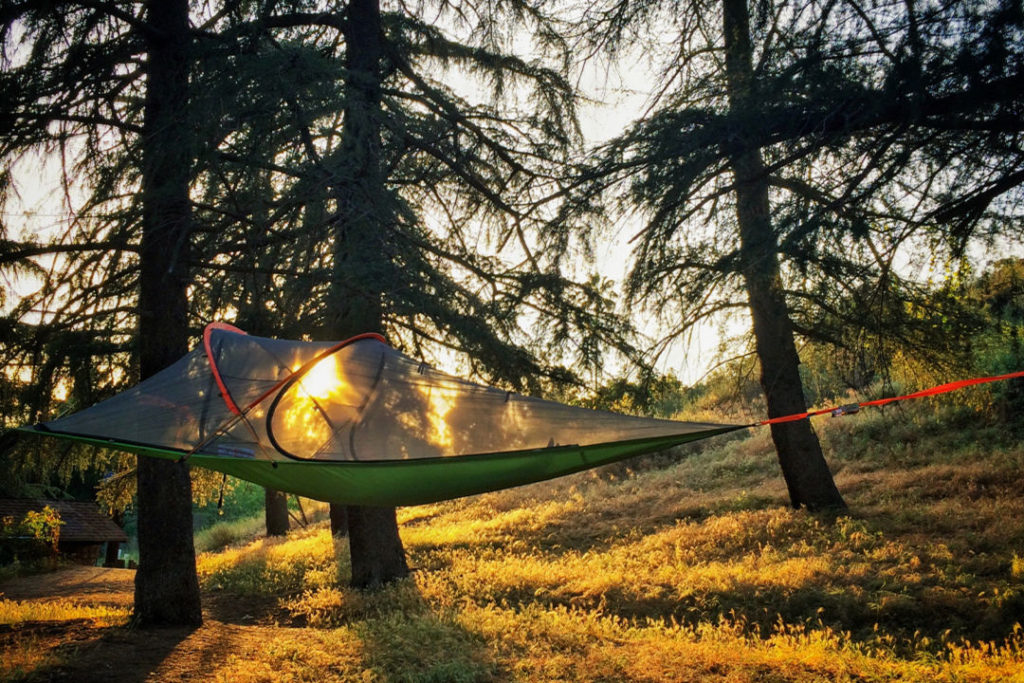
What should you consider before hammock camping?
I won’t call these cons, but there are some things to think about if you plan to go hammock camping, such as:
- Money. Remember how we said hammock camping can mean saving money because you don’t need a tent or sleeping pad? Well, there are some other accessories you may need to consider depending on where you’re headed, like a rainfly, tarp, bug net, underquilt, etc. These things may add up (but they won’t add up to the weight of a tent, that’s for sure).
- Terrain (mostly just trees). Likely you have a hammock tent that requires straps and, therefore, trees, so you’ll need to make sure you’ll have some options ranging anywhere from 10-20 feet apart. Though, there are some hammock camping setups that don’t require trees, so you could go the route of folding hammocks with stands.
- Protection/shelter. Again, there are accessories you can add on to offer extra protection from the elements, but they won’t be the same as sleeping in the comfort of a tent, especially a three- or four-season tent.
- Solo sleeping only. Unlike tents, hammock camping is really made for single person use. On that same token, there isn’t much storage space even if you opt for a large tarp. The tarp will protect some gear near the hammock, and you can hang gear from the ridgeline or straps, but it’s much more limited than what you can fit inside a tent.
Different types of camping hammocks
When it comes to hammocks for sleeping overnight, there are generally three options to consider:
- Nylon hammock with tent-like accessories. Maybe you like the idea of a small, portable hammock but need a bit more protection, like a bug net, rain tarp, or insulation? This might do the trick.
- Hammock-tent hybrid. Or, perhaps you need to get a little more horizontal to get a good’s night sleep. Camping hammocks that look like tents are perfect for back, stomach or side sleepers.
- Folding hammock with a stand. But, what if you won’t have trees where you’re going but still love the idea of sleeping in a hammock? Check these out.
We’ve pulled together the best camping hammocks for each of these scenarios. Our top picks take into account quality, design, accessories, comfort, and price.
Hammock Comparison Chart
We also created this handy hammock comparison chart that lets you sort nearly 90 portable, lightweight hammocks by price, size, weight, capacity, and more. It includes hammocks for everyday adventures, kids, backpacking, and more.
When you buy something using links in our stories, we may earn a small commission. Read more about our policy.
The best camping hammocks with tent-like accessories
Many of the hammocks we featured in this post on the best portable hammocks can certainly be used for camping. Whether you’re looking for something to use around the campsite, take on day hikes, or spend the night in, they’re small and lightweight, and therefore plenty portable.
If you’re looking to ditch the tent altogether and get a hammock you can sleep in all night, there are a few specific options that offer extra protection in the form of bug nets, rainflies, and tarps. You could also piecemeal together a sleep system using an existing hammock and adding some extra protective elements.
- Tarps and rainflies. Something to think about is how much protection this extra piece of shelter is really going to give you. If the forecast calls for light showers, you might be fine getting away with a small tarp. A diamond-shape tarp can be used to cover the hammock by being tied to the trees and then the ground using guy lines. If you need more side protection, a rectangular tarp can be draped over a ridgeline over the hammock and extended down either side to create an enclosed area. This would keep gusts of wind out, as well as protect from heavier rain.
- Mesh bug net. So you know you need something to keep the bugs out. One thing to consider is whether to get a hammock with an attached mesh net or a detachable net. While it may seem easier to have it all in one unit, it might be nice to have the option of removing it altogether if you know you won’t need it or don’t want the extra weight. Or if you want to forgo the net during the day when there are no bugs. The good news is you can add a mesh net to any hammock, so no need to buy one that’s attached unless you know that’s what you want.
- Insulation. We did a whole post on hammocking in the winter that breaks down insulation options in more detail. Essentially, you have two choices for keeping warm in a hammock: an underquilt or a sleeping pad. Several brands sell underquilts that you can attach around the bottom of the hammock to help keep warm. The benefit of having the underquilt outside the hammock is that you don’t flatten it with your body weight. And no matter how much tossing and turning you do, it’ll stay snuggly in place. Otherwise, there are sleeping pads you can bring into the hammock with you—designed to bend and fold with you and the hammock. Or, Hennessy Hammock (below) sells double bottom hammocks so you can slip an insulation pad between you and the elements, yet you aren’t directly on it, which means it stays better in place.
Hennessy Hammock’s 4Season Survivorman
Hennessy Hammock makes some of the toughest hammock sleeping systems, which they describe as survival hammocks. They’ve teamed up with Canadian bushcraft icon Les Stroud to introduce the 4Season Survivorman. This hammock is created for tough, challenging environments and comes with a survival kit bag and a Survivorman bandana with survival tips from Les.
This rugged hammock is designed for all four seasons and comes with an oversize, compressible open cell foam pad for bottom insulation. The hammock actually has a double bottom, which allows for extra insulation if needed, such as clothing, dry grass or leaves.
Other survival kit components include a space blanket, fluorescent cord, compass, candle, mini LED light, whistle and lanyard, fire striker and starter fuel, razor blade with needle and thread—all in a zippered pouch with Survivorman logo.
While the bug net comes attached to the hammock, the 70D Hex Fly—Hennessy’s largest rain fly—is detachable, providing protection from bad weather and enough space to set up camp in comfort.
They truly thought of everything by making the interior of the hammock emergency orange. It can be used to signal search and rescue efforts.
Kammok Mantis All-in-One Hammock Tent
This all-in-one hammock tent comes with a breathable hammock body, insect net, and featherlight rainfly. It is smaller than most sleeping bags and lighter than a one-person tent, at 2 lbs 12 oz. Not to mention, it’s easier to set up—and tear down—than a tent.
The removable mesh top is Kammok’s own Dragonet™ no-see-um mesh canopy, providing ultimate insect protection. The Mantis also includes a structural ridgeline and built-in storage pockets. When the weather is nice, ditch the fly and look through the Stargazer™ panel to the night’s sky.
Kammok Sunda Tent Hammock
Note: this model is currently out of stock while Kammok prepares to unveil its redesign later this year
The Sunda is a tent hammock designed for any occasion and every terrain. It’s a two-person tent and all-in-one hammock. The Sunda comes with a fly light shelter tent body that can be set up on the ground or over the hammock using the ridgeline. The kit comes with a solo hammock, though you can comfortably sleep two people inside the tent when it’s pitched from the ground. The kit also includes python coils and a footprint. Use the ridgeline to stay bug-free or flip it over for a mesh-free hang. The Sunda offers a large internal space with cross-ventilation and several storage options with mesh pockets and gear loops.
The best camping hammock-tent hybrids
Camping hammock tents are for the experienced camper/backpacker who just might be ready to elevate their tent game (literally). We have tested the two leading camping hammocks and can personally vouch for them. While different, they both have their perks. And unlike traditional hammocks, these are meant to be hung taut, creating flat bottoms for a good night’s sleep.
Lawson Blue Ridge Camping Hammock

For a complete and detailed report on this one-man camping hammock, read our full gear review. Essentially, it’s a tent that is suspended like a hammock, giving you a protected place to sleep. It has a bug net and you’re elevated off the ground, so there’s no need for a sleeping pad. Unless it’s cold.
The other big difference with this model is the spreader bar. This helps keep the hammock flat for a more comfortable sleeping area. This will be is preferred by any stomach sleepers.
Check out the Lawson camping hammock and its warming underquilt.
Tentsile
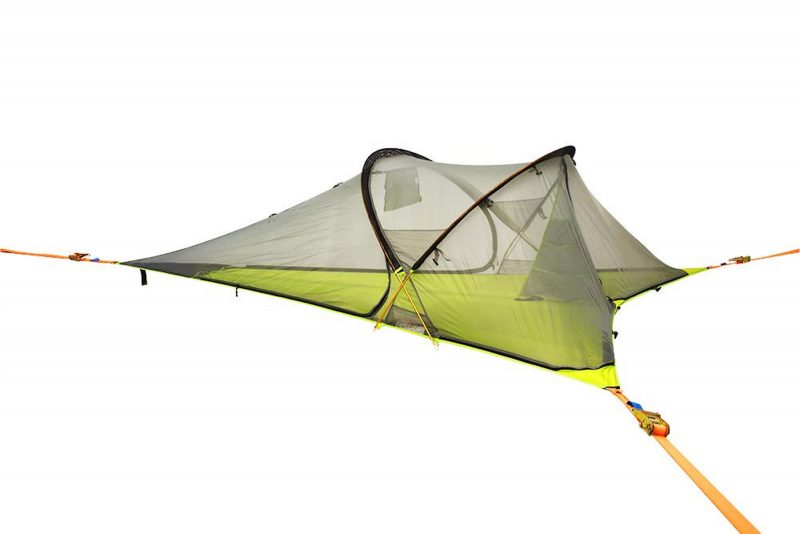
We have to admit it, this is the most impressive hammock tent setup that exists on planet Earth. We have the Connect 2-Person Tent Tree and love it. Read the full review here.
It’s a triangle shape that sort of resembles some futuristic spacecraft and requires three trees to hang. It’s very high quality and durable, so there’s no concerns about jumping in and being safe sleeping all night—with a companion or two.
Check out the various types of Tentsile Tree Tents. And, they also sell their cool triangle shapes in a more open air hammock style.
BONUS! Use this discount code “affiliateFX755H” to save an extra 10% off.
The best freestanding, folding hammocks with frames
Another great option for camping hammocks are freestanding hammocks that come with folding frames. These are great because don’t require trees. Some campsites don’t have great hammock trees, so having a self-sufficient hammock would come in handy. Also, some folding hammocks are more like cots and get you in a better horizontal position.
We actually have a whole blog post dedicated to the various types of foldable hammocks. Each has certain pros and cons, so definitely check it out. In the meantime, here are a few of our personal favorites.
The Mock ONE by Republic of Durable Goods
Minnesota-based Republic of Durable Goods came out with the Mock ONE folding hammock in 2018. This compact and portable hammock comes with a stand that puts you about 18″ off the ground once you’re in place. the biggest selling point is what little space is takes up on the ground (36″ x 24″), which comes in handy when large, flat surfaces are scarce in the outdoors.
It folds up to the size of a regular quad chair and weighs under 15 lbs, which is one of the lightest options in this category. The Mock ONE can hold 250 lbs. and comfortably fits people up to 6’4″ with feet extending past the foam padded ends.
Another differentiator is that it’s available in multiple colors —currently orange, green, and blue. It also comes with a sun shade, side pockets, drink pockets, a mesh basket under your booty for more storage, and a carrying bag. And if you want to add-on, they’ve got you covered. This hammock has tons of options you can buy for even more comfort and convenience, including an attachable pillow, quilt for warmth, tarp for rain and shade, and net for bugs.
Portable Fold Up Hammock by Mac Sports
This folding hammock is the only one on the list that comes with a full canopy to protect you from the sun. You can also easily remove it, making it a nice add-on when needed.
Another handy addition is the mesh net that hangs below the hammock for some light storage.
Best of all? Setup for this guy takes a matter of seconds. They say it unfolds in 5 and you can be set up in another 10 seconds, making it ideal for camping or outdoor adventures. The strong collapsible steel frame makes it easy to transport and stow, and it comes with a carry bag, as well as a matching pillow.
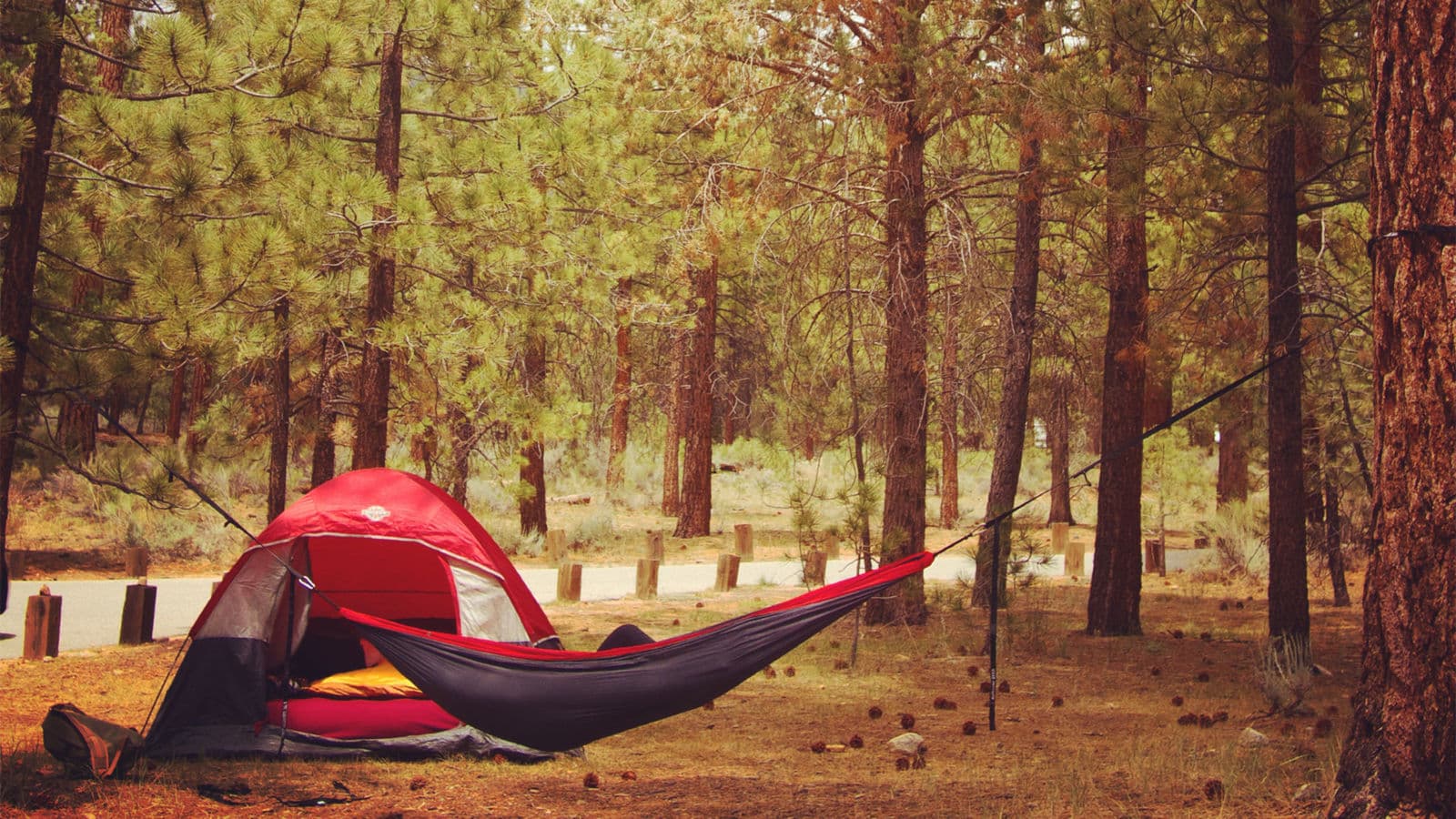
Hammock Buying Guide
We’ve done all the research for you in this fool-proof guide to hammock shopping—what to consider before purchasing, and a look at the different types of hammocks available and what they’re best used for.

